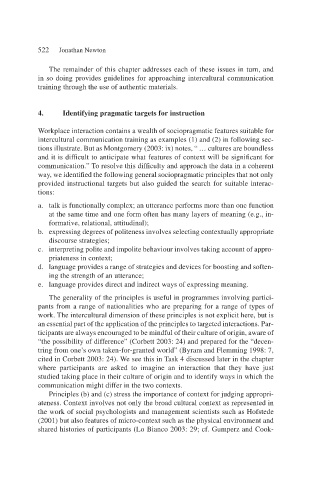Page 544 - Handbooks of Applied Linguistics Communication Competence Language and Communication Problems Practical Solutions
P. 544
522 Jonathan Newton
The remainder of this chapter addresses each of these issues in turn, and
in so doing provides guidelines for approaching intercultural communication
training through the use of authentic materials.
4. Identifying pragmatic targets for instruction
Workplace interaction contains a wealth of sociopragmatic features suitable for
intercultural communication training as examples (1) and (2) in following sec-
tions illustrate. But as Montgomery (2003: ix) notes, “ … cultures are boundless
and it is difficult to anticipate what features of context will be significant for
communication.” To resolve this difficulty and approach the data in a coherent
way, we identified the following general sociopragmatic principles that not only
provided instructional targets but also guided the search for suitable interac-
tions:
a. talk is functionally complex; an utterance performs more than one function
at the same time and one form often has many layers of meaning (e.g., in-
formative, relational, attitudinal);
b. expressing degrees of politeness involves selecting contextually appropriate
discourse strategies;
c. interpreting polite and impolite behaviour involves taking account of appro-
priateness in context;
d. language provides a range of strategies and devices for boosting and soften-
ing the strength of an utterance;
e. language provides direct and indirect ways of expressing meaning.
The generality of the principles is useful in programmes involving partici-
pants from a range of nationalities who are preparing for a range of types of
work. The intercultural dimension of these principles is not explicit here, but is
an essential part of the application of the principles to targeted interactions. Par-
ticipants are always encouraged to be mindful of their culture of origin, aware of
“the possibility of difference” (Corbett 2003: 24) and prepared for the “decen-
tring from one’s own taken-for-granted world” (Byram and Flemming 1998: 7,
cited in Corbett 2003: 24). We see this in Task 4 discussed later in the chapter
where participants are asked to imagine an interaction that they have just
studied taking place in their culture of origin and to identify ways in which the
communication might differ in the two contexts.
Principles (b) and (c) stress the importance of context for judging appropri-
ateness. Context involves not only the broad cultural context as represented in
the work of social psychologists and management scientists such as Hofstede
(2001) but also features of micro-context such as the physical environment and
shared histories of participants (Lo Bianco 2003: 29; cf. Gumperz and Cook-

